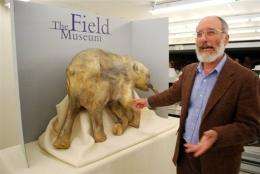A replica of the world's best preserved wooly mammoth - a 40,000 year old baby named Lyuba who was discovered in Siberia in 2007 - is described by curator and geologist Daniel Fisher at Chicago's Field Museum on September 30. The Field Museum will be the first in North America to display Lyuba's body, which is currently undergoing analysis in Russia, in an exhibit which opens on March 5.
Sucked to her death in a muddy river bed, a baby woolly mammoth spent 40,000 years frozen in the Siberian permafrost where her body was so perfectly preserved traces of her mother's milk remained in her belly.
Three years after her discovery by nomadic reindeer herders, Lyuba will head to Chicago as the star of a mammoths and mastodons exhibit at the world-famous Field Museum.
The exhibition, announced at mid-week, opens March 5 and will run through September 6. The Field Museum is the first US museum to display the prehistoric specimen.
"There's a visceral awe that takes hold of you in looking at a specimen like Lyuba, and the exhibition as a whole demonstrates how close we can come to knowing what these animals were like," said lead curator Daniel Fisher, a professor of geological sciences at the University of Michigan who is part of the international team studying the remains.
Lyuba -- who was about a month old when she died -- has already taught researchers much about mammoths that they had been unable to glean from fossils and other less well preserved finds.
"We had no idea from preserved skeletons and preserved carcasses that young mammoths had a discrete structure on the back of the head of brown fat cells," Fisher told reporters.
The hump acted as a furnace to help maintain body temperature in cold climate, which supports the theory that mammoths were born in the early spring.
Lyuba appeared to be in perfect health when she died and researchers found sediment and mud in her mouth, trunk and throat which indicates that she suffocated while struggling to free herself from a mud hole or slurry.
She is intact enough to yield DNA, but "no one is on the threshold of cloning at this point," Fisher said.
Lubya then embarks on a 10-city tour whose final stop is scheduled for the Natural History Museum of London in 2014.
(c) 2009 AFP




















